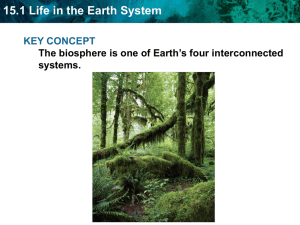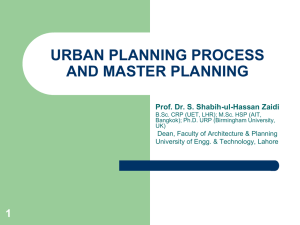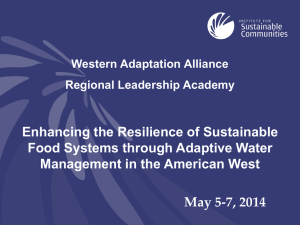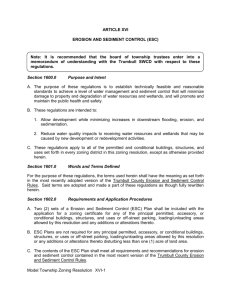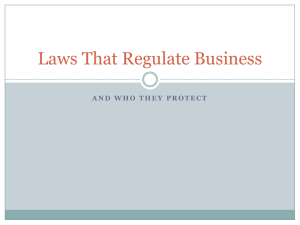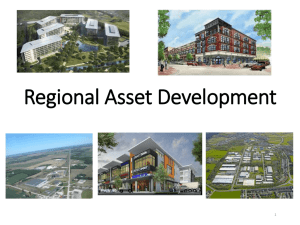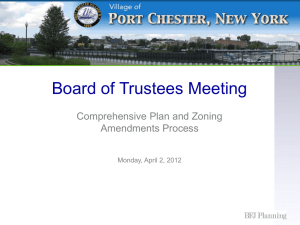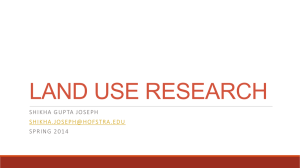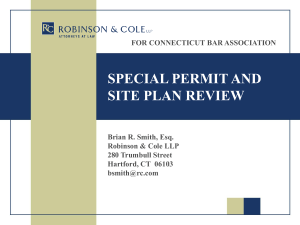Protected Area Management Planning * ZONING
advertisement
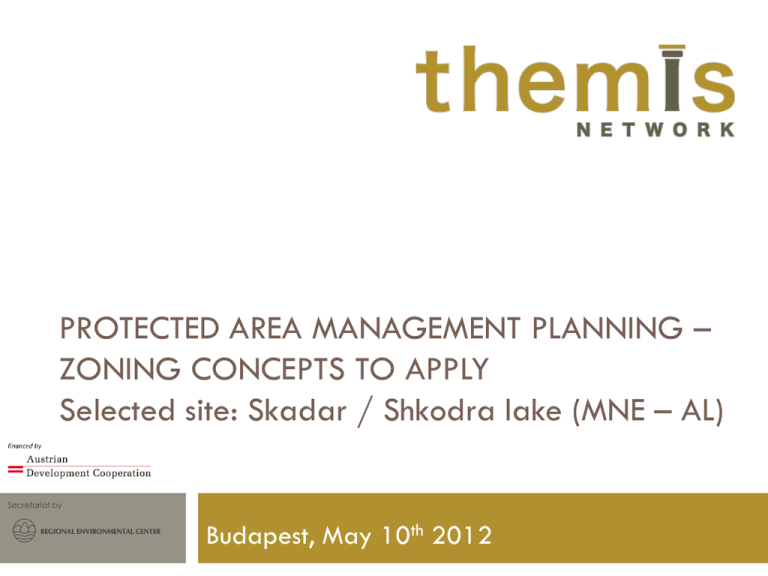
PROTECTED AREA MANAGEMENT PLANNING – ZONING CONCEPTS TO APPLY Selected site: Skadar / Shkodra lake (MNE – AL) Secretariat by Budapest, May 10th 2012 Protected Area Management Planning PROCESS EVENT Future oriented Approach Systematic Holistic Involve Value judgement Mechanism for solving problems Achieve the mandate of an Protected area (hereinafter PA) PROTECTED AREA is an area of land and/or sea especially dedicated to the protection of biological diversity, and of natural and associated cultural resources, and managed through legal or other effective means” (IUCN 1994). Management by objectives PROACTIVE Result oriented Product: MANAGEMENT PLAN documenting management approach BASIC STEPS: 1. formulation of clear, concise statements or objectives; 2. development of realistic action plans for their attainment (including an analysis of threats to attaining the objectives); 3. systematic monitoring and measuring of performance and achievement; and 4. taking corrective actions necessary to achieve planned results. Other plans associated to the Management Plan Operational plans ~ annual work plan, for implementing specific type of actions of a Managent plan Corporate plans flow from Managent plan(s); how manager – agency (direct managemnt authority) should operate Bussiness plans examine how goods and services of an PA should be used in the relation to the market Sectoral plans are for specific but dominating sector(s) in an PA (visitor management, species protection etc) Conservation plans are mostly used for the sites with dominant cultural values or mixed nature and culture sites Site management plans are for the areas that require intensive management in a PA (visitor attractive site) Other plans associated to the Management Plan Development plan are to guide investments in infrastructure, facilities (physical objects) Master plans ~ Managent plans used in 70ties for managing PAs their interpretation and development Physical (Spatial) plans ~ Land use plans are legal and practical base for relevant aspects in the Management plan(s) Zoning plans define diferent zones that should be managed in diferent ways. Zoning plan is part of a Management plan Zoning plan(s) – concept(s) (step1: formulate objectives of PA MP) Define “management zones” “Zoning defines what can and cannot occur in different areas of the park in terms of natural resources management; cultural resources management; human use and benefit; visitor use and experience; access; facilities and park development; maintenance and operations. Through management zoning the limits of acceptable use and development in the park are established” (Young and Young 1993). (Where management objectives should be acomplished, in compliance with Protected Area Management categories (IUCN) ) Zoning plan(s) – concept(s) (step1: formulate objectives of PA MP) Define “management zones” “Zoning defines what can and cannot occur in different areas of the park in terms of natural resources management; cultural resources management; human use and benefit; visitor use and experience; access; facilities and park development; maintenance and operations. Through management zoning the limits of acceptable use and development in the park are established” (Young and Young 1993). (Where management objectives should be acomplished, in compliance with Protected Area Management categories (IUCN) ) Management objectives by Protected Area Management categories (IUCN) Managementt objectives Ia Ib II III IV V VI Scientific research 1 3 2 2 2 2 3 Wildeness protection 2 1 2 3 3 - 2 Preservation of species and genetic diversity 1 2 1 1 1 2 1 Maintenence of environmental /eco services 2 1 1 - 1 2 1 Protection of specific natural /cultural features - - 2 1 3 1 3 Tourism and recreation - 2 1 1 3 1 3 Education - - 2 2 2 2 3 Sustainable use of resources from natural ecosystems - 3 3 - 2 2 1 Mantenance of cultural / traditional atributes - - - - - 1 2 Key: 1: primary objective, 2: secondary objective, 3: potentaly applicable objective, - not applicable IUCN Protected Area Management Categories CATEGORY I Strict Nature Reserve/Wilderness Area: protected area managed mainly for science or wilderness protection CATEGORY la Strict Nature Reserve: protected area managed mainly for science CATEGORY Ib Wilderness Area: protected area managed mainly for wilderness protection CATEGORY II National Park: protected area managed mainly for ecosystem protection and recreation CATEGORY Ill Natural Monument: protected area managed mainly for conservation of specific natural features CATEGORY IV Habitat/Species Management Area: protected area managed mainly for conservation through management intervention CATEGORY V Protected Landscape/Seascape: protected area managed mainly for landscape/seascape conservation and recreation CATEGORY VI Managed Resource Protected Area: protected area managed mainly for the sustainable use of natural ecosystems Mmanagement zones (in IUCN Protected Area Categories I–IV) Special and/or unique values zone Primitive wilderness zone Limited development zone Intensive development / service zone Traditional / national regimes of protection: Regime / Zone I – strict protection Regime / Zone II – active protection Regime / Zone III – sustainable use Protective zone / belt UNESCO – M&B principles for zoning Biosphere Reserves Linking functions to space For further reading: Bioret, F.; Cibien, C.; G&tot, J.-C.; Lecomte, J. 1998 A Guide to Biosphere Reserve Management: a Methodology Applied to French Biosphere Reserves. MAB Digest 19. UNESCO, Paris UNESCO, 1996: Biosphere Reserves: The Seville Strategy and the Statutory Framework of the World Network, UNESCO, Paris Types of protection / Management zone in Biosphere Reserves Biosphere Reserve types of the protection / management zone: “Core area” – national protection and effective management in place “Buffer zone” – support protection in “core area”, ecologicaly sound sustainable development Transition area – sustainable (economic) development Traditional / national regimes of protection: Regime / Zone I – strict protection Regime / Zone II – active protection Regime / Zone III – sustainable use Protective zone / belt Selected site for zoning excercise – Skadar / Shkodra Lake (MNE – AL) Cross-border water body shared between MNE and AL Protected Area in both countries: National Park in MNE and Protected area in AL, Ramsar site, IBA site, IPA site, EMERALD sites and possible Biosphere Reserve Oportunities: (i) preparation of the documentation for nominating Skadar / Shkodra Lake as an Biosphere Reserve (IPA project: INCA Tirana and Green Home Podgorica) 2011-12 (ii) Management Strategy for Skadar / Shkodra Lake (REC Podgorica for World Bank and MoEs project LSIEMP – GEF). Draft. 2012 Identified priority habitats and species for conservation Water and water related habitats and species asociated to these habitats (aquatic vegetation, water invertebrates, fish, birds, reptiles and amphibians Suit to “core area” / Special values zone / Zone I – strict protection Mapping excercise Settlements excluded from “core area” / special values zone / zone I Zoning excercise in transboundary context – provide a topographic base Different geographic projections in topographic maps in MNE and AL Available topographic maps – VGI Bgd, scale 1:50.000 and 1:100.000 Topographic base made: sections Titograd 1 -4 (50.000) and excerpt of Skadar (1:100.000), both VGI Bgd Zoning concept – applied criteria in the Zoning plan • • In compliance with spatial distribution of key natural resources: water and water related habitats are prioritized for CORE AREA – SPECIAL VALUES ZONE, i.e. 1st regime of protection, for-called active protection. Core area – special values zone (Ia and Ib), as zone(s) of strict protection that are within the administrative borders of existing Protected areas (National Park in Montenegro and Nature Managed Reserve in Albania) Buffer zone – limited development zone is zone for 2nd regime of protection that support zone of strict protection, follow the terrain Transition area – (intensive) development zone is zone for 3rd regime of protection as a wider protective zone dedicated for development. Main criteria used in the proposed zoning concept are: (i) Water and water related habitats are prioritized for ZONE I, i.e. 1st regime of strict protection, for so-called active protection, (ii) Settlements and Infrastructure are excluded from the zone I Core zone, (iii) Key economic activities are excluded from Core area and Buffer Zone to the maximum possible extent and delineated in the Transition zone, while Buffer zone remain for settlements / housing, small scale infrastructure and environmentally friendly activities, including agriculture adapted to local conditions. Preliminary Zoning plan for Joint Skadar / Shkodra Lake Management Strategy and proposed Transboundary Biosphere Reserve Skadar Lake Thank you for your atention


